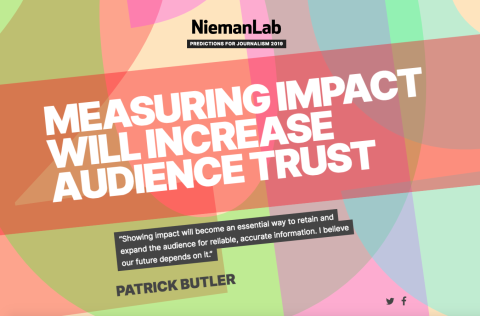
This article first appeared Dec. 13 on Nieman Lab, as part of an annual feature asking thought leaders in journalism and digital media to share predictions for the coming year.
News organizations have gotten very good at measuring things like impressions, reach, and engagement. We are great at determining who is reading our content, how long they spend with it, and how they are sharing it.
What we don’t do well is measure why our content matters. Did a story help anyone make a better healthcare decision, contact a city council member, or spend money more wisely?
Did it prompt officials to fix a dangerous traffic intersection, improve services for the homeless or tighten policies that were enabling corruption? In other words, did it lead to something actionable that helped our audiences?
In 2019, the news media will step up its efforts to measure their impact on society, and not just because it will make us feel better. We are facing an unprecedented crisis in media credibility. One way to regain the trust of our audiences — and potential audiences — is to show them that journalism plays a vital role in making their lives better.
The McClatchy newsrooms, for example, are making the case for credibility and trust through their #ReadLocal campaign. It highlights important investigations and stories that have led to concrete changes in the lives of their readers. This initiative goes one step beyond how other news outlets are actively engaging with their audiences through social media, live events, and other activities that were traditionally not part of the newsroom’s work.
The Center for Investigative Reporting, ProPublica, and Gannett are among other media groups that have made a priority of tracking the impact of their stories. Leading the effort for Gannett is Anjanette Delgado, senior news director for digital at the Detroit Free Press. She first helped develop Impact Tracker for the Journal News Media Group, also part of Gannett. The investigative team there felt that traditional audience metrics didn’t capture major changes triggered by their stories. Now, the entire Gannett USA Today Network can use the new tool to determine which stories have the most impact.
The trend reaches beyond U.S. borders. ICFJ Knight Fellow Pedro Burgos has pioneered an impressive tool in Brazil that uses automation to find instances of how journalism creates positive change. His tool is called Impacto, and six media partners in Brazil are using it to scrape public documents, social media, and academic research to reveal when a story made a difference.
Impacto can detect whether a story was cited by influencers — such as legislators including it in a bill to fight corruption or city officials citing it as a reason for cleaning up a dump site.
The premise is that by tracking examples of impact and sharing them with audiences, trust in the media will grow. One of the newspapers using Impacto, for example, maps every instance of impact, so when a reader calls to cancel a subscription, staffers can check the map and show the caller how the paper has improved quality of life in that person’s neighborhood.
A big part of Pedro’s project, which is also supported by Google News Lab, is not just to develop and test Impacto. It’s to make media organizations aware of the importance of measuring impact, whatever tool they choose to use. He has spoken about this at conferences throughout the Americas, and met with newsrooms in five countries, including the U.S. The reaction is usually an enthusiastic “Yes! How can we do this?”
In 2019 and beyond, there will be an increasing number of new tools that news organizations can use to do just that. Showing impact will become an essential way to retain and expand the audience for reliable, accurate information. I believe our future depends on it.